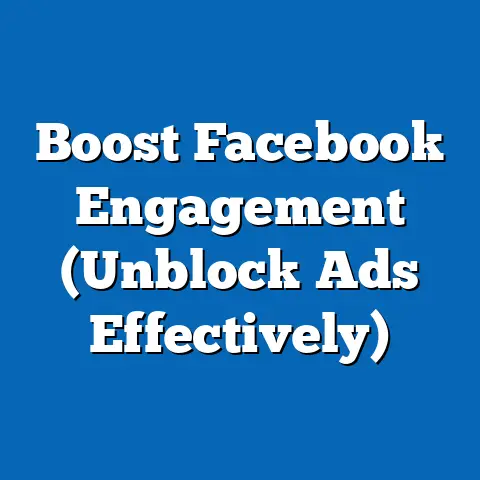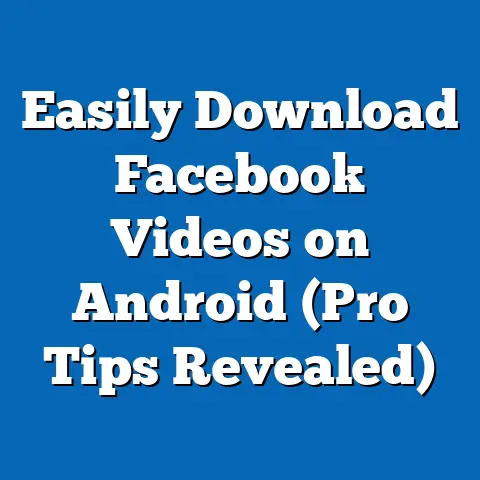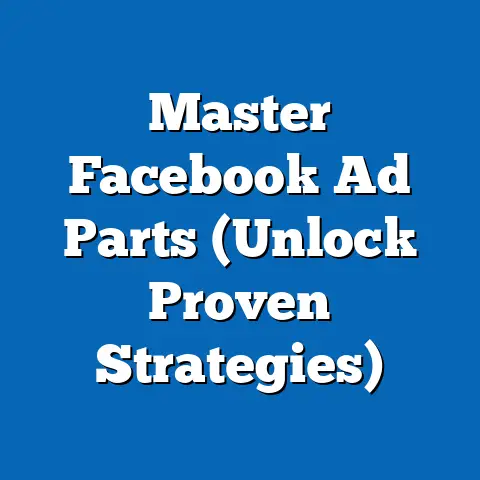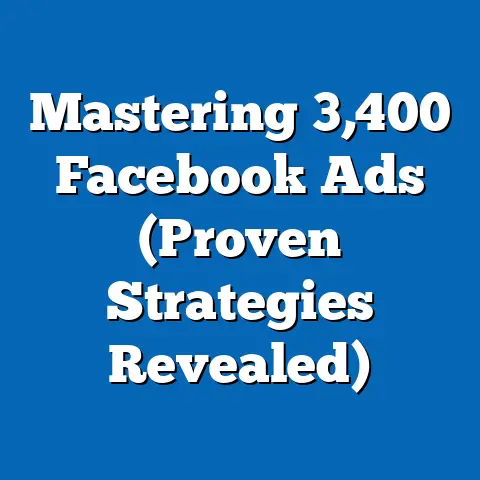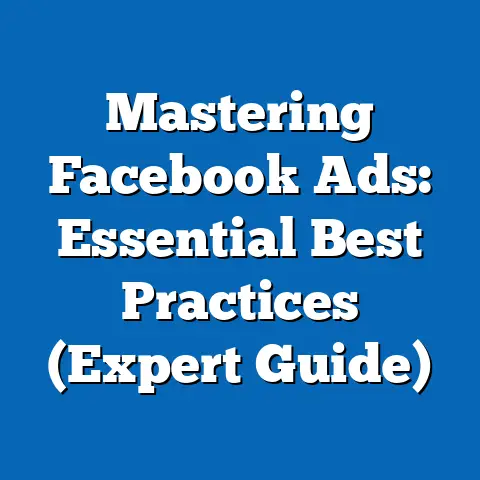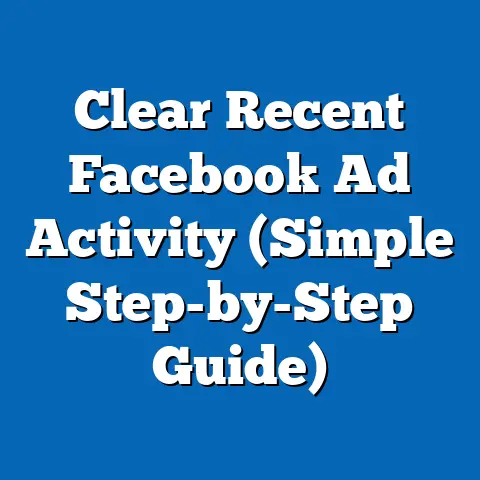Master YouTube Facebook Ads for Maximum Impact (Expert Tips)
I’ve seen firsthand how the advertising landscape has drastically changed. Gone are the days of relying solely on traditional methods. Today, businesses thrive by embracing the power of digital, and at the forefront of this revolution are YouTube and Facebook. The synergy between these two platforms, when harnessed effectively, can create an advertising powerhouse.
Think about it: YouTube, the world’s second-largest search engine, is a video haven where people spend hours consuming content. Facebook, with its massive user base and sophisticated targeting capabilities, offers unparalleled reach. By strategically combining YouTube video ads with Facebook’s audience precision, I’ve helped countless businesses not only reach a wider audience but also deeply engage them, resulting in significant boosts in revenue, brand awareness, and customer loyalty.
I’ve seen small businesses, struggling to gain traction, completely transform their marketing strategies through effective YouTube Facebook Ads. One example that sticks with me is a local bakery that used a short, engaging YouTube video showcasing their delicious treats. By targeting foodies and local residents on Facebook, they drove a surge of traffic to their website and, more importantly, to their physical store. Their sales increased by 30% within a month!
This article is your guide to mastering the art of YouTube Facebook Ads. I’ll walk you through the fundamentals, share expert tips on crafting compelling content, delve into the intricacies of targeting and retargeting, and equip you with the knowledge to measure and optimize your campaigns for maximum impact. Let’s dive in!
Understanding the Basics of YouTube Facebook Ads
So, what exactly are YouTube Facebook Ads, and why should you care? Simply put, they’re a strategic combination of video advertising on YouTube and targeted advertising on Facebook, designed to amplify your message and reach the right audience at the right time.
YouTube: Think of YouTube as your video stage. You create engaging video content that showcases your brand, product, or service. These videos can be displayed as in-stream ads (playing before, during, or after other videos), discovery ads (appearing in search results or suggested videos), or bumper ads (short, memorable ads).
Facebook: Now, picture Facebook as your precision targeting tool. Facebook’s powerful advertising platform allows you to target specific demographics, interests, behaviors, and even custom audiences based on your existing customer data.
The magic happens when you combine these two. You create compelling video content on YouTube and then use Facebook’s targeting capabilities to ensure that your video ads are seen by the people most likely to be interested in your offer.
Key Differences & Synergies:
- Format: YouTube is primarily video-focused, while Facebook supports various formats, including images, text, and video.
- Targeting: Both platforms offer robust targeting options, but Facebook’s detailed demographic and interest-based targeting is particularly powerful.
- Audience: While there’s overlap, YouTube tends to attract users actively searching for information or entertainment, while Facebook users are often passively browsing.
- Synergy: The key is to use YouTube to deliver engaging video content and Facebook to ensure that content reaches the right audience.
Different Ad Types & Use Cases:
- YouTube In-Stream Ads: These ads play before, during, or after other videos. They’re great for brand awareness and telling a story. Use Case: A car manufacturer showcasing the features of their latest model.
- YouTube Discovery Ads: These ads appear in search results or suggested videos. They’re ideal for driving traffic to your website or YouTube channel. Use Case: A software company promoting a free trial of their product.
- Facebook Video Ads: These ads appear in the Facebook newsfeed and can be used for a variety of purposes, from brand awareness to lead generation. Use Case: A local restaurant promoting a special offer.
- Facebook Sponsored Content: Partnering with influencers to create and promote content on Facebook can be a highly effective way to reach a new audience. Use Case: A beauty brand collaborating with a makeup artist to demonstrate their products.
Takeaway: Understanding the unique features and capabilities of both YouTube and Facebook is crucial for creating effective ad campaigns. By strategically combining video content with precise targeting, you can reach a wider audience and achieve your marketing goals.
Crafting Compelling Ad Content
Let’s be honest, in today’s world of digital advertising, content is king. If your ad content doesn’t grab attention, resonate with your audience, and inspire action, it’s simply going to get lost in the noise. This is especially true for video ads on YouTube and Facebook, where users are constantly bombarded with content.
I’ve learned that the key to creating compelling ad content is storytelling. People don’t want to be sold to; they want to be entertained, informed, and inspired. Your video ads should tell a story that connects with your audience on an emotional level.
Expert Tips for Creating Impactful Video Ads:
- Storytelling is Key: Craft a narrative that resonates with your target audience. Focus on solving their problems, fulfilling their desires, or simply entertaining them.
- Scriptwriting Matters: A well-written script is essential for keeping your audience engaged. Start with a strong hook, maintain a clear message, and end with a compelling call to action.
- Video Production Quality: Invest in good quality video production. This doesn’t necessarily mean hiring a professional film crew, but it does mean using good lighting, sound, and editing.
- Visual Elements: Use visually appealing graphics, animations, and footage to capture attention and enhance your message.
- Strong Hook: The first few seconds of your ad are crucial. Use a captivating visual, a thought-provoking question, or a surprising statement to grab your audience’s attention.
- Effective Calls-to-Action (CTAs): Tell your audience what you want them to do. Use clear and concise CTAs that encourage them to visit your website, sign up for your email list, or make a purchase.
- Brand Identity: Ensure that your ad content aligns with your brand identity. Use consistent colors, fonts, and messaging to reinforce your brand image.
Aligning Ad Content Across Platforms:
While it’s important to tailor your ad content to each platform, it’s also crucial to maintain a consistent brand message. Your YouTube ads and Facebook ads should complement each other and reinforce your overall brand identity.
For example, you might use a longer, more in-depth video on YouTube to showcase your product’s features and benefits, and then use a shorter, more visually appealing video on Facebook to drive traffic to your website.
Takeaway: Compelling ad content is the foundation of a successful YouTube Facebook Ads campaign. By focusing on storytelling, investing in quality video production, and aligning your content with your brand identity, you can create ads that capture attention, resonate with your audience, and drive results.
Now, how do you make sure the right people see it? That’s where targeting and retargeting come in. These strategies are the backbone of any successful YouTube Facebook Ads campaign. They allow you to laser-focus your advertising efforts, ensuring that your message reaches the people most likely to be interested in your offer.I’ve seen countless campaigns fail simply because they weren’t properly targeted. It’s like throwing a dart in the dark and hoping to hit the bullseye. With targeted advertising, you’re aiming with precision.
Utilizing Facebook’s Robust Targeting Options:
Facebook’s targeting options are incredibly powerful. You can target users based on:
- Demographics: Age, gender, location, education, relationship status, etc.
- Interests: Hobbies, interests, pages they like, etc.
- Behaviors: Purchase history, online activity, device usage, etc.
- Custom Audiences: Upload your own customer data (email lists, phone numbers) to target your existing customers on Facebook.
- Lookalike Audiences: Create audiences that are similar to your existing customers. This is a great way to reach new potential customers who are likely to be interested in your offer.
Retargeting: Re-Engaging Potential Customers:
Retargeting is the process of showing ads to people who have previously interacted with your content or visited your website. This is a highly effective strategy because these users have already shown some level of interest in your brand.
For example, you can retarget:
- Website Visitors: Show ads to people who have visited specific pages on your website.
- Video Viewers: Show ads to people who have watched a certain percentage of your YouTube videos.
- Facebook Page Engagers: Show ads to people who have liked, commented, or shared your Facebook posts.
Strategies for Creating Custom and Lookalike Audiences:
- Custom Audiences:
- Email Lists: Upload your email list to Facebook and target your existing customers with special offers or promotions.
- Website Traffic: Install the Facebook Pixel on your website to track visitor behavior and create custom audiences based on their activity.
- App Activity: If you have a mobile app, you can create custom audiences based on app usage.
- Lookalike Audiences:
- Seed Audience: Choose a high-quality custom audience as your seed audience (e.g., your top 10% of customers).
- Audience Size: Experiment with different audience sizes to find the sweet spot between reach and relevance.
- Location: Target lookalike audiences in specific locations to reach potential customers in your target market.
- Email Lists: Upload your email list to Facebook and target your existing customers with special offers or promotions.
- Website Traffic: Install the Facebook Pixel on your website to track visitor behavior and create custom audiences based on their activity.
- App Activity: If you have a mobile app, you can create custom audiences based on app usage.
- Seed Audience: Choose a high-quality custom audience as your seed audience (e.g., your top 10% of customers).
- Audience Size: Experiment with different audience sizes to find the sweet spot between reach and relevance.
- Location: Target lookalike audiences in specific locations to reach potential customers in your target market.
Effectively Re-Engaging Potential Customers:
- Personalized Ads: Use personalized ads that address the specific actions that users have taken. For example, if someone abandoned their shopping cart on your website, show them an ad reminding them of the items they left behind.
- Exclusive Offers: Offer exclusive discounts or promotions to retargeted users to incentivize them to take action.
- Frequency Capping: Limit the number of times that users see your ads to avoid ad fatigue.
Takeaway: Targeting and retargeting are essential for maximizing the impact of your YouTube Facebook Ads. By utilizing Facebook’s robust targeting options and implementing effective retargeting strategies, you can reach the right audience, re-engage potential customers, and drive conversions.
Measuring Success and Optimizing Campaigns
You’ve created compelling video ads, you’ve targeted the right audience, and now it’s time to measure your success and optimize your campaigns for maximum impact. This is where data analysis and continuous improvement come into play.
I’ve seen many businesses launch ad campaigns and then simply sit back and hope for the best. But the truth is, successful advertising requires constant monitoring, analysis, and optimization.
Key Performance Indicators (KPIs) to Track:
- Click-Through Rate (CTR): The percentage of people who see your ad and click on it. A high CTR indicates that your ad is relevant and engaging to your target audience.
- Conversion Rate: The percentage of people who click on your ad and then complete a desired action, such as making a purchase or signing up for your email list.
- View Rate: The percentage of people who watch your video ad to completion. A high view rate indicates that your video is engaging and holds your audience’s attention.
- Engagement Metrics: Likes, comments, shares, and other forms of engagement on your ads. These metrics provide valuable insights into how your audience is reacting to your content.
- Cost Per Click (CPC): The amount you pay each time someone clicks on your ad.
- Cost Per Conversion (CPC): The amount you pay for each conversion that you generate.
- Return on Ad Spend (ROAS): The amount of revenue you generate for every dollar you spend on advertising.
Tools and Metrics for Analysis:
- Facebook Ads Manager: Facebook’s built-in advertising platform provides detailed data on your ad performance.
- YouTube Analytics: YouTube Analytics provides insights into your video views, engagement, and audience demographics.
- Google Analytics: Google Analytics can be used to track website traffic and conversions from your Facebook and YouTube ads.
Analyzing Ad Performance Data:
- Identify Trends: Look for patterns in your data to identify what’s working and what’s not.
- Segment Your Data: Break down your data by demographics, interests, and behaviors to identify your most valuable audience segments.
- Compare Different Ad Creatives: A/B test different ad creatives to see which ones perform best.
- Track Your Competitors: Monitor your competitors’ ad campaigns to identify opportunities for improvement.
Strategies for A/B Testing:
- Test One Variable at a Time: When A/B testing, only change one variable at a time so you can accurately measure the impact of that change.
- Test Headlines, Images, and CTAs: These are some of the most important elements of your ad, so focus your A/B testing efforts on them.
- Use a Control Group: Always have a control group that sees the original version of your ad so you can compare the results.
Optimizing Ad Placements, Creatives, and Targeting:
- Ad Placements: Experiment with different ad placements to see which ones perform best for your target audience.
- Ad Creatives: Continuously test and optimize your ad creatives to improve your click-through rates and conversion rates.
- Targeting: Refine your targeting based on your data to reach the most relevant audience segments.
Takeaway: Measuring success and optimizing your campaigns is an ongoing process. By tracking the right KPIs, analyzing your data, and implementing effective optimization strategies, you can continuously improve your ad performance and maximize your ROI.
Conclusion
Mastering YouTube Facebook Ads is no longer a luxury; it’s a necessity for businesses seeking to thrive in today’s competitive digital landscape. I’ve shown you the transformative potential of strategically combining video advertising on YouTube with Facebook’s precision targeting capabilities.
I encourage you to embrace the strategies I’ve discussed and start implementing them in your own advertising efforts. Experiment with different ad formats, target specific audience segments, and continuously optimize your campaigns based on data-driven insights.
The world of digital advertising is constantly evolving, so it’s important to stay informed and adaptable. Keep learning, keep experimenting, and keep pushing the boundaries of what’s possible.
I’d love to hear about your experiences and success stories in leveraging YouTube Facebook Ads for your business growth. Share your insights in the comments below!
Remember, the key to success is to start small, learn from your mistakes, and never stop innovating. Go out there and create some amazing YouTube Facebook Ads that drive real results for your business!

